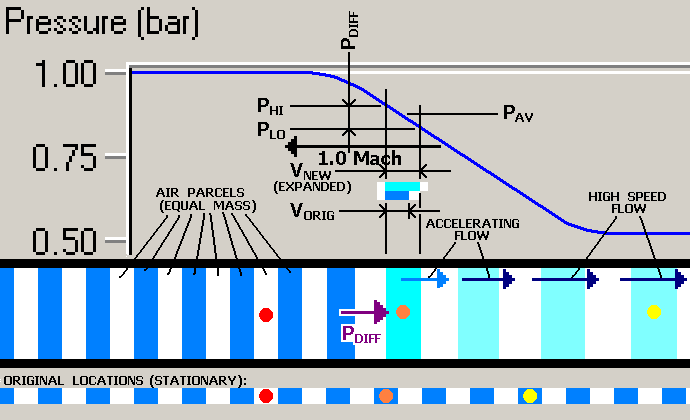|
The Non-Mathematician's Guide To
Basic Valveless Pulsejet Theory
© 2008 Larry Cottrill
by Larry Cottrill 25 Sep 2008
Section 03.03.04
Air Flow Lite
Our final "microscopic" example illustrates a couple of additional kinds of actions that a
wave can do (although the underlying physical principles are exactly the same, of course).
Here we see that we can just as easily have a low pressure wave as a high one, and we
also see that expansion doesn't stop when we get to a "normal" air condition. Again we
assume (only for the sake of simplicity) that we start out with normal air that is stationary
in the pipe. A descending wave front that is the leading edge of a low pressure wave advancing
(just as before, from right to left):

The length of the parcels are now shown at a somewhat smaller scale, in order to clearly show
the expansion. Again, the compressibility of air approximately obeys an inverse law -- if we
reduce the absolute pressure by half, as shown here, the parcels will expand to almost
double their normal volume! The forward speed is also radically increased, as indicated
by the displacement shown for the orange- and yellow-dotted parcels. Note that this is really
the same action shown for the "trailing edge" of a high pressure wave, shown immediately
above -- the PHI pressure acts rightward and the PLO
pressure leftward, so the net pressure result is a rightward-acting PDIFF
vector (shown acting on the orange-dotted mass). So, there is an acceleration to the right,
with a resulting final high speed flow in that direction. The reduced density is indicated by
the very light blue of the colored parcels. As you might expect, the temperature of the
accelerated parcels has dropped significantly, as well.
One important thing illustrated here is that the passage of a low pressure wave has exactly
the opposite influence of a high pressure wave on the air mass in the pipe. Such
a wave can have just as much air-moving power as a high pressure wave, but always acts to make
a change in mass motion in the opposite direction to the traverse direction of the wave.
This is true regardless of the direction the wave is moving in the pipe, of course. The
"trailing edge" of such a wave would restore the air to its original condition, but displaced
some distance opposite to the direction of the wave traverse.
Go back to select
another Section
Next Section: On
Further Reflection ...
|